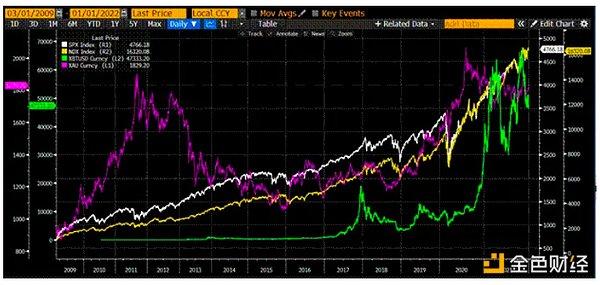This article is machine translated
Show original
"Non-mainstream" opinion on $GMX and $GLP.
There are already many descriptions of the GMX/GLP mechanism and comparisons with other perp dexes on the Internet, so there is no need to repeat them. However, 95% of the content is too much, and the really important things are not demonstrated.
The following breaks some misunderstandings or omissions in "mainstream thinking".
1/268
#GMX #GLP
index guide
Chapter 1: GLP is not Delta Neutral, but it is an advantage in a certain time and space, not a disadvantage
Chapter 2: Andrew Kang Appears, GLP Severe Losses?
Chapter 3: The Advantage of Being Hidden
Chapter 4: Misunderstandings of Comparing Trading Volume, TVL vs Market Cap
Chapter 5: Expensive Valuations = Coming Down?
Chapter 6: FDV Too High? Unlimited inflation?
...More?
First things first. Whenever I see a tweeter claiming that GLP will "enter a death spiral", "insolvency", or "be killed by a trader",
Nothing more than proved that the pusher:
* in malicious fud, or
*Limited level of knowledge
Then we go to chapters 1 and 2.
This official statistical chart is probably the most misleading chart ever.
The most important point to master the GLP mechanism is to understand that under the unilateral rising market conditions of GLP, even if 100% of Traders are long, GLP will still not lose money in the U-standard.
Why? I illustrate with examples.
Suppose there are 10 ETH and 10,000 USDCs in GLP (BTC is omitted for simplicity). ETH now = $1000. Now GLP is fully balanced with a net value of $20000.
Now Mr. A deposits 1 ETH as collateral, open 7 times more ETH, and the position size reaches the maximum limit of 7 ETH (max cap is about 70% of GLP’s ETH holdings). The price of ETH to open a position is $1000.
Ten days later, ETH rose to $1500, and Mr. A left the market with a profit. What is the net worth of GLP now?
Important point: ETH is taken away by bulls, not USDC.
All trader positions are 100% supported by substantial assets
(That is to say, there is no real leverage in GLP!)
This is the most important design of GLP.
Therefore, when Mr. A leaves the market, he takes 7 ethers, and needs to deduct the opening principal of 7x$1000, and other charges such as close fee and borrow fee (GMX will withdraw [swap] 7900 from it before delivering 7 ethers USDC, assuming all fees are 900 USDC)
Refer to Andrew Kang's multi-position close transaction demonstration: arbiscan.io/tx/0xc1cc7fb669be5...
What was taken was ether.
Summary: GLP has 3 ETH remaining (@$1500) + 10000+7000+(900x0.7) USDC = $4500 + $17630 = $22130. (Press: 30% of the fee belongs to $ GMX staker)
Compared with ten days ago, GLP is still up 10.5%.
As far as the U standard is concerned, GLP did not lose money, but "earned less", because 7 ETH originally held were taken away.
Of course, in terms of the currency standard, this can be said to be a "loss".
Referring to the GLP+fee price chart in the figure, during the period when Andrew Kang won money from mid-January to early February, GLP price did not fall against the market.
Key conclusion!
In the unilateral rally of the bull market, even if traders concentrate on long positions, GLP still enjoys "positive delta" and can earn part of the increase in ETH/ BTC(because GMX has a max cap, which does not allow the utilization rate of ETH/ BTC to exceed ~70%)
And the higher the usage rate of ETH/ BTC, the more expensive the APR of the borrow fee.
Recently, Andrew Kang paid the rate of ~60% APR for more than half a month, and paid close to 4 million magnesium from the profit of ~6 million
In the reference picture, when Andrew Kang drives max long to the end, the borrow fee is as high as 60+%
Why is the GLP design an advantage?
Because in a bull market, GLP investors don't have to worry about (U standard) losing money at all!
The delta of GLP is always greater than 0, which has become a safe investment in the bull market without completely missing Shenglang, and the APR is higher than that of stablecoins.
For investors who pursue prudence, GLP has better income than stable coins in the bull market, but it will not be over-exposed. GLP holds all mainstream coins.
Relatively speaking, in a bull market, the delta neutral betting vault becomes more risky. Because you are very vulnerable to the impact of trader long profit!
GLP holds the risk asset mechanism, which just resists this kind of impact.
GLP will lose some potential gains, but this is something every GLP investor should be aware of before buying.
This is a bit like selling a covered call option. You have to be willing to sacrifice some potential upside in return for fee income.
This is also similar to the Curve Tricrypto AMM LP pool. When ETH rises, AMM will always sell ETH in exchange for U. This is the IL concept that everyone is already familiar with.
GLP does not have the IL of swap, but the implicit IL of GLP is trader profit.
#impermanentloss
In a bull market, the proper way to buy GLP is to use U to buy, then you will be invincible.
Smart you will ask, what about the bear market?
That's right, in a bear market, if the trader is one-sided and open short, the situation will be very different.
At that time, GLP will be "won" USDC by traders in exchange for (buying) more ETH and BTC.
In the worst case, GLP may have 15% of U, 85% of ETH, and BTC left (assuming that the max cap of opening position is 30%)
pay attention to! Since there is no real leverage in GLP (real leverage is always less than 100%), even in the worst case, it is still impossible to be insolvent (even if ETH and BTC return to zero, GLP still holds a certain amount of USDC).
In a bear market, the best way to invest in GLP is to maintain a delta neutral hedging strategy. When buying GLP, it is best to use ETH or BTC(sell half of the holdings in disguise)
Note that at this time, other pure stable currency gambling vaults are not necessarily safer, because traders can still win money one-way.
Does this mean that the mechanism of GLP is necessarily better?
Not necessarily. GLP always holds the characteristic of risky assets, which becomes a trouble for people who have no intention of holding ETH, BTC, or staunch supporters of delta neutral.
The gambling fund pool of a single stable currency is always easier to understand.
Moreover, the design of GLP, its currency holding type limits the options that GMX can support transactions. The efficiency of fund use is far less than that of a single betting pool (because GLP has a certain proportion of assets that cannot be moved for a long time)
In the next GMX v4 synthetic trading contract, the design advantages of the two will be combined to solve the problem of limited trading options.
Chapters 1 and 2 are over.
27/268
There are enough readers to write chapters 3, 4, 5, and 6~
Additional corrections. When rereading, I saw that the calculation process in yesterday's example was wrong. Because I changed the unit where Mr. A opened a position in the middle of writing, and I didn't change all the words. The following recalculates the calculation method of Mr. A's final net value of GLP when he opens 7 ETH at $1000 and settles at $1500.
TLDR: The calculation method has been changed, but the result is still the same. Only the method of GLP accounting is modified.
When Mr. A leaves the market, assume that the receivable fee is $900. Then he should earn money=($1500-$1000)x7 -$900 = $2600 = 2600/1500 ETH = 1.733 ETH (fee will be deducted)
The resulting net value of GLP is (10-1.733) ETH + 10000 USDC - ($900x0.3) = $12400 + $10000 - $270 = $22130
(Press: 30% of the fee must belong to $ GMX staker)
The final result of the calculation is the same as yesterday.
@ThreadReaderApp unroll
Unrolled my GMX/GLP Series #1:
threadreaderapp.com/thread/162...
Sector:
From Twitter
Disclaimer: The content above is only the author's opinion which does not represent any position of Followin, and is not intended as, and shall not be understood or construed as, investment advice from Followin.
Like
Add to Favorites
Comments
Share





